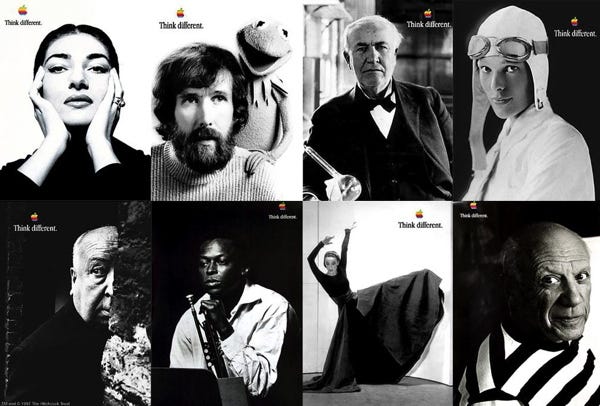The Power of Storytelling in Business: 3 Hot Takes.
Storytelling isn’t just for authors, marketers, or branding experts—it’s for everyone who wants to make a mark in the business world.

When done right, storytelling can be the most powerful tool in your arsenal. But not all stories are created equal, and not all businesses understand how to use this power effectively.
Here are my 3 hot takes on why storytelling should be at the heart of your business strategy—and how to get it right.
🔥Storytelling is the New Product Feature
Let me take you back to a time when Apple wasn’t the powerhouse it is today. The year was 1997, and Apple was on the brink of bankruptcy.
Steve Jobs had just returned to the company, and he knew they needed more than just a great product to survive—they needed a story that would resonate with people.
Jobs didn’t start by listing the technical specs of the new iMac; instead, he launched the “Think Different” campaign.
The ad didn’t even show the product.
Instead, it celebrated visionary thinkers like Einstein, Gandhi, and Picasso. The message was clear: Apple wasn’t just selling a computer; it was selling a way to challenge the status quo, to be creative, to “think different.”
That story changed everything. The iMac flew off the shelves, not just because it was a great product, but because people wanted to be part of that story. They wanted to be part of the revolution. This wasn’t about features—it was about belonging to something bigger.
In today’s market, where products and services are becoming more and more similar, the story you tell around your offering can be your biggest differentiator.
Features can be copied, but the emotional connection created by a story is unique to your brand. If you want to stand out, stop focusing solely on what your product does and start telling the story of why it matters.
🔥🔥Internal Storytelling is Just as Important as External
Imagine you’re a member of NASA’s team in 1961, just after President Kennedy declared that America would land a man on the moon by the end of the decade.
This wasn’t just a technical challenge—it was a massive narrative shift, one that required everyone at NASA to buy into a story that seemed almost impossible at the time.
To get everyone on board, NASA didn’t just issue memos or hold meetings.
They told stories.
Stories of exploration, of pushing the boundaries of what was possible, of being part of something historic. Everyone, from engineers to janitors, was made to feel like a crucial part of this epic journey.
The result? A unified team, driven by a shared story that made the impossible possible.
When Neil Armstrong set foot on the moon in 1969, it wasn’t just a victory for NASA—it was a victory for storytelling. The narrative had been so powerful that it motivated an entire organization to achieve what had never been done before.
Your employees are the frontline storytellers of your brand. If they don’t believe in the story you’re telling, no one else will either.
It’s not enough to simply inform them of new strategies or products—they need to be part of the story from the beginning. Share the vision, the challenges, and the potential impact.
Make them heroes in the narrative, and they’ll be your most powerful advocates.
🔥🔥🔥Data Doesn’t Speak Without a Story
Let’s talk about how the New York City Police Department transformed their fight against crime in the 1990s. The NYPD had access to endless amounts of crime data—every incident, every arrest, every detail meticulously recorded. But despite all this information, crime was still rampant in many parts of the city.
Enter CompStat, a program that revolutionized the way the NYPD used data. But CompStat wasn’t just about crunching numbers; it was about telling a story with that data.
The department began holding regular meetings where commanders had to present not just statistics, but narratives—what the numbers meant, why crime was happening in specific areas, and how they planned to address it.
This storytelling approach forced commanders to think strategically, connect the dots, and make the data come alive.
Crime rates in New York City plummeted, and the city saw its safest years in decades. The data alone didn’t create change; it was the story around that data that drove action.
Inside a CompStat meeting. Photo: Bryan R. Smith/The New York Times/Redux
The lesson here is clear: Facts and figures appeal to the rational mind, but stories connect with emotions and drive action.
If you want to make your data meaningful, you need to wrap it in a narrative that resonates with your audience.
Storytelling in business isn’t just a nice-to-have—it’s a must-have.
Whether you’re differentiating your product, rallying your team, or making sense of data, the right story can be your most powerful tool.
The best stories are the ones that are authentic, relatable, and meaningful. They’re not just about your brand or your product; they’re about the people who interact with them, the problems you solve, and the impact you create.
So, what’s your story? And more importantly, how are you telling it?






